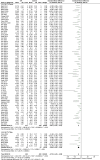Lipopolysaccharide-Induced Bone Loss in Rodent Models: A Systematic Review and Meta-Analysis
- PMID: 36401814
- PMCID: PMC10107812
- DOI: 10.1002/jbmr.4740
Lipopolysaccharide-Induced Bone Loss in Rodent Models: A Systematic Review and Meta-Analysis
Abstract
Osteoporosis has traditionally been characterized by underlying endocrine mechanisms, though evidence indicates a role of inflammation in its pathophysiology. Lipopolysaccharide (LPS), a component of gram-negative bacteria that reside in the intestines, can be released into circulation and stimulate the immune system, upregulating bone resorption. Exogenous LPS is used in rodent models to study the effect of systemic inflammation on bone, and to date a variety of different doses, routes, and durations of LPS administration have been used. The study objective was to determine whether systemic administration of LPS induced inflammatory bone loss in rodent models. A systematic search of Medline and four other databases resulted in a total of 110 studies that met the inclusion criteria. Pooled standardized mean differences (SMDs) and corresponding 95% confidence intervals (CI) with a random-effects meta-analyses were used for bone volume fraction (BV/TV) and volumetric bone mineral density (vBMD). Heterogeneity was quantified using the I2 statistic. Shorter-term (<2 weeks) and longer-term (>2 weeks) LPS interventions were analyzed separately because of intractable study design differences. BV/TV was significantly reduced in both shorter-term (SMD = -3.79%, 95% CI [-4.20, -3.38], I2 62%; p < 0.01) and longer-term (SMD = -1.50%, 95% CI [-2.00, -1.00], I2 78%; p < 0.01) studies. vBMD was also reduced in both shorter-term (SMD = -3.11%, 95% CI [-3.78, -2.44]; I2 72%; p < 0.01) and longer-term (SMD = -3.49%, 95% CI [-4.94, -2.04], I2 82%; p < 0.01) studies. In both groups, regardless of duration, LPS negatively impacted trabecular bone structure but not cortical bone structure, and an upregulation in bone resorption demonstrated by bone cell staining and serum biomarkers was reported. This suggests systemically delivered exogenous LPS in rodents is a viable model for studying inflammatory bone loss, particularly in trabecular bone. © 2022 The Authors. Journal of Bone and Mineral Research published by Wiley Periodicals LLC on behalf of American Society for Bone and Mineral Research (ASBMR).
Keywords: BIOCHEMICAL MARKERS OF BONE TURNOVER; BONE HISTOMORPHOMETRY; DUAL-ENERGY X-RAY ABSORPTIOMETRY (DXA); MICRO-COMPUTED TOMOGRAPHY; PRECLINICAL STUDIES.
© 2022 The Authors. Journal of Bone and Mineral Research published by Wiley Periodicals LLC on behalf of American Society for Bone and Mineral Research (ASBMR).
Conflict of interest statement
E.M.C. received research support from Lallemand Health Solutions and Ocean Spray and consultant fees or speaker and travel support from Danone and Lallemand Health Solutions. (All are outside of this study.)
R.J.d.S. has served as an external resource person to the World Health Organization's (WHO) Nutrition Guidelines Advisory Group on
Figures







Similar articles
-
A systematic review and meta-analysis of the effects of probiotics on bone outcomes in rodent models.J Bone Miner Res. 2024 Dec 31;40(1):100-113. doi: 10.1093/jbmr/zjae187. J Bone Miner Res. 2024. PMID: 39545776 Free PMC article.
-
Bone Microarchitecture and Strength in Long-Standing Type 1 Diabetes.J Bone Miner Res. 2022 May;37(5):837-847. doi: 10.1002/jbmr.4517. Epub 2022 Mar 8. J Bone Miner Res. 2022. PMID: 35094426 Free PMC article.
-
Systemic bone loss and induction of coronary vessel disease in a rat model of chronic inflammation.Bone. 2006 Mar;38(3):378-86. doi: 10.1016/j.bone.2005.09.008. Epub 2005 Oct 26. Bone. 2006. PMID: 16256450
-
Best Performance Parameters of HR-pQCT to Predict Fragility Fracture: Systematic Review and Meta-Analysis.J Bone Miner Res. 2021 Dec;36(12):2381-2398. doi: 10.1002/jbmr.4449. Epub 2021 Oct 18. J Bone Miner Res. 2021. PMID: 34585784 Free PMC article.
-
Opportunistic Screening Using Low-Dose CT and the Prevalence of Osteoporosis in China: A Nationwide, Multicenter Study.J Bone Miner Res. 2021 Mar;36(3):427-435. doi: 10.1002/jbmr.4187. Epub 2020 Nov 4. J Bone Miner Res. 2021. PMID: 33145809 Free PMC article.
Cited by
-
Oncostatin M: Dual Regulator of the Skeletal and Hematopoietic Systems.Curr Osteoporos Rep. 2024 Feb;22(1):80-95. doi: 10.1007/s11914-023-00837-z. Epub 2024 Jan 10. Curr Osteoporos Rep. 2024. PMID: 38198032 Free PMC article. Review.
-
A systematic review and meta-analysis of the effects of probiotics on bone outcomes in rodent models.J Bone Miner Res. 2024 Dec 31;40(1):100-113. doi: 10.1093/jbmr/zjae187. J Bone Miner Res. 2024. PMID: 39545776 Free PMC article.
-
Associations between gut microbiota and incident fractures in the FINRISK cohort.NPJ Biofilms Microbiomes. 2024 Aug 14;10(1):69. doi: 10.1038/s41522-024-00530-8. NPJ Biofilms Microbiomes. 2024. PMID: 39143108 Free PMC article.
-
A Whey-Based Diet Can Ameliorate the Effects of LPS-Induced Growth Attenuation in Young Rats.Nutrients. 2023 Apr 10;15(8):1823. doi: 10.3390/nu15081823. Nutrients. 2023. PMID: 37111042 Free PMC article.
-
Dusp1 in osteolytic diseases-mechanisms and therapeutic potential.Sci Rep. 2025 Jul 1;15(1):20887. doi: 10.1038/s41598-025-05142-6. Sci Rep. 2025. PMID: 40594392 Free PMC article.
References
-
- International Osteoporosis Foundation . Epidemiology of osteoporosis and fragility fractures. Facts and Statistics 2022. Available from: https://www.osteoporosis.foundation/facts-statistics/epidemiology-of-ost....
-
- Epidemiology of Osteoporosis and Fragility Fractures . Facts & Statistics [cited 2021 July 17]. Available from: https://www.osteoporosis.foundation/facts-statistics/epidemiology-of-ost....
-
- Organization WH . WHO Scientific Group on the Assessment of Osteoporosis at Primary Health Care Level. Brussels, Belgium: World Health Organization; 2004.
-
- Oden A, McCloskey EV, Kanis JA, Harvey NC, Johansson H. Burden of high fracture probability worldwide: secular increases 2010‐2040. Osteoporos Int. 2015;26(9):2243‐2248. - PubMed
Publication types
MeSH terms
Substances
LinkOut - more resources
Full Text Sources
Research Materials
Miscellaneous

